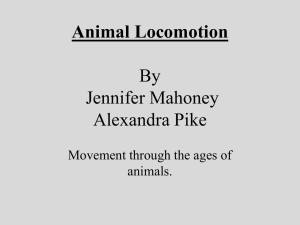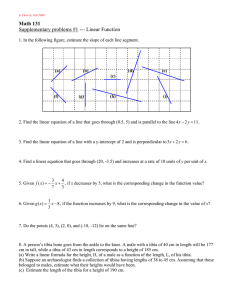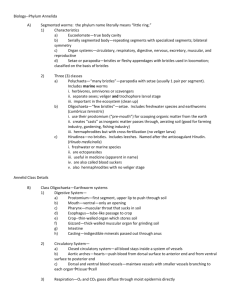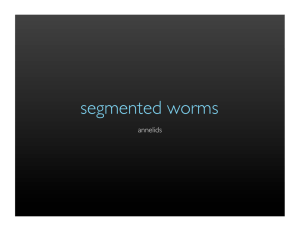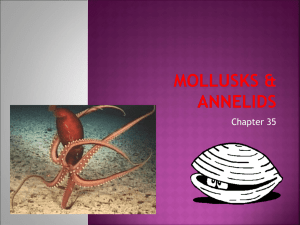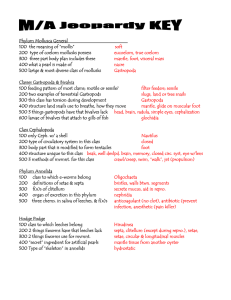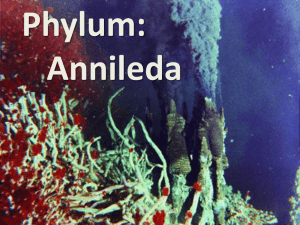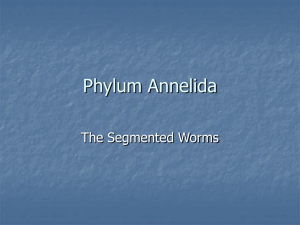NEW SPECIES OF LONG-LEGGED FLIES (DIPTERA: DOLICHOPODIDAE) FROM CENTRAL PENNSYLVANIA J B. R
advertisement
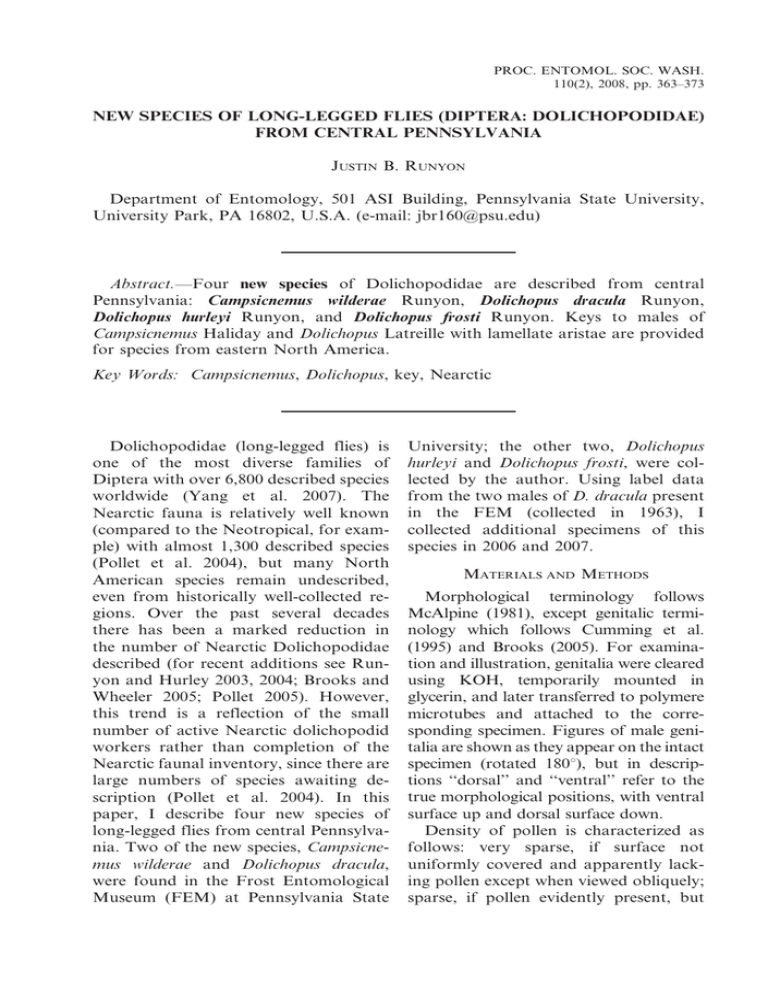
PROC. ENTOMOL. SOC. WASH. 110(2), 2008, pp. 363–373 NEW SPECIES OF LONG-LEGGED FLIES (DIPTERA: DOLICHOPODIDAE) FROM CENTRAL PENNSYLVANIA JUSTIN B. RUNYON Department of Entomology, 501 ASI Building, Pennsylvania State University, University Park, PA 16802, U.S.A. (e-mail: jbr160@psu.edu) Abstract.—Four new species of Dolichopodidae are described from central Pennsylvania: Campsicnemus wilderae Runyon, Dolichopus dracula Runyon, Dolichopus hurleyi Runyon, and Dolichopus frosti Runyon. Keys to males of Campsicnemus Haliday and Dolichopus Latreille with lamellate aristae are provided for species from eastern North America. Key Words: Campsicnemus, Dolichopus, key, Nearctic Dolichopodidae (long-legged flies) is one of the most diverse families of Diptera with over 6,800 described species worldwide (Yang et al. 2007). The Nearctic fauna is relatively well known (compared to the Neotropical, for example) with almost 1,300 described species (Pollet et al. 2004), but many North American species remain undescribed, even from historically well-collected regions. Over the past several decades there has been a marked reduction in the number of Nearctic Dolichopodidae described (for recent additions see Runyon and Hurley 2003, 2004; Brooks and Wheeler 2005; Pollet 2005). However, this trend is a reflection of the small number of active Nearctic dolichopodid workers rather than completion of the Nearctic faunal inventory, since there are large numbers of species awaiting description (Pollet et al. 2004). In this paper, I describe four new species of long-legged flies from central Pennsylvania. Two of the new species, Campsicnemus wilderae and Dolichopus dracula, were found in the Frost Entomological Museum (FEM) at Pennsylvania State University; the other two, Dolichopus hurleyi and Dolichopus frosti, were collected by the author. Using label data from the two males of D. dracula present in the FEM (collected in 1963), I collected additional specimens of this species in 2006 and 2007. MATERIALS AND METHODS Morphological terminology follows McAlpine (1981), except genitalic terminology which follows Cumming et al. (1995) and Brooks (2005). For examination and illustration, genitalia were cleared using KOH, temporarily mounted in glycerin, and later transferred to polymere microtubes and attached to the corresponding specimen. Figures of male genitalia are shown as they appear on the intact specimen (rotated 180u), but in descriptions ‘‘dorsal’’ and ‘‘ventral’’ refer to the true morphological positions, with ventral surface up and dorsal surface down. Density of pollen is characterized as follows: very sparse, if surface not uniformly covered and apparently lacking pollen except when viewed obliquely; sparse, if pollen evidently present, but 364 PROCEEDINGS OF THE ENTOMOLOGICAL SOCIETY OF WASHINGTON Fig. 1. Campsicnemus wilderae, leg II of male. A, Posterior view of femur, tibia, and basitarsus. B, Dorsal view of tibia. not noticeably modifying integument color; moderately dense, if pollen lending its own color generally to the surface, but not completely obscuring integument beneath; dense, if integument completely hidden by pollen. Legs are designated by roman numerals, tarsomeres by bracketed arabic numerals (e.g., Tarsus III(4) 5 4th tarsomere of metathoracic leg). The following acronyms for museums are used: CNC 5 Canadian National Collection, Ottawa; FEM 5 Frost Entomological Museum, Pennsylvania State University, University Park; MTEC 5 Montana Entomology Collection, Montana State University, Bozeman; USNM 5 National Museum of Natural History, Smithsonian Institution, Washington, D.C. Campsicnemus wilderae Runyon, new species (Fig. 1) Male.—Body length 2 mm; wing length 2 mm. Face short, not reaching lower margin of eyes, very narrow near 1/2 where eyes almost contiguous; covered with dense, golden brown pollen. Front black with violet reflections and very sparse brown pollen. Palpus and proboscis black, with moderately dense, light brown pollen; former with a few black hairs. Scape and pedicel brown, with ventral 1/3 brownish yellow. First flagellomere brown, about as long as wide, broadly triangular, with rounded apex. Arista with short pubescence, about twice as long as scape, pedicel, and first flagellomere combined; inserted dorsally near base of first flagellomere. Uppermost postocular setae black, ventral setae brown and appearing paler in certain lights. Scutum covered with dense, dark brown pollen; with violet reflections when viewed from above; with 5 pairs of dorsocentral setae, anterior pair 1/2 length of remaining dorsocentrals; with single row of 5–6 small (5 1/4 length of largest dorsocentral setae), delicate acrostichal setae, this row ends posteriorly at transverse suture. Scutellum with 1 strong medial seta and 1 small lateral hair (5 1/5 length of medial) / side; posterior margin with 3 slender hairs medially. Pleura, including metepimeron, covered with dense, dark brown pollen and dusted with slight gray pollen. Legs dark brown to black, except apex of coxa I narrowly yellow. Leg I and III unmodified. Coxa I with delicate, rather sparse, pale hairs anteriorly; with black seta on anterodorsal margin at 2/3; with black setae at apex. Tibia I with small dorsal seta just before 1/2 and small posteroventral seta just beyond 1/2. Femur II (Fig. 1A) not swollen; with row of short (, width of femur II) ventral setae full length, this row becoming posteroventral apically; with a few very short, blunt setae anteroventrally on apical 1/4; with hairs on anterior surface longer than those on posterior surface. Tibia II (Figs. 1A,B) black; gradually thickened to just beyond 1/2, thickened portion ending in a short, wartlike protuberance anteriorly which bears 5– 6 short, blunt setae at apex; basal 1/3 bearing a series of short, blunt setae on ventral surface; with large anterodorsal seta just beyond 1/3, 1/2, and at 3/4; with VOLUME 110, NUMBER 2 subapical seta dorsally and anteroventrally; with large, rather stout, apical posteroventral seta. Tarsus II(1) (Fig. 1A) somewhat curved, bearing a short, stout anterodorsal spine near apex and a spurlike projection at tip. Tibia III with 3 anterodorsal, 3 posterodorsal, and 2–3 anteroventral setae. Ratio of tibia:tarsomeres for leg I: 18-10-5-4-3-3; for leg II: 27-8-6-5-3-4; for leg III: 33-8-10-6-4-4. Wings rather narrow; hyaline, evenly tinged with light brown; without spots; R4+5 and M1 nearly parallel to slightly divergent beyond crossvein dm-cu. Calypter brown, with black apex and black setae. Halter dark brown. Abdomen concolorous with scutum, but lacking violet reflections; somewhat flattened dorsoventrally, with black hairs and setae. Hypopygium small, embedded; cerci partially hidden, dark brown with dense, pale hairs. Female.—Unknown. PENNSYLVANIA: Holotype.—-, Centre Co., State College, Jan. 18 1973 (D. D. Wilder) (USNM). Etymology.—The species epithet honors Dr. Dee Wilder, who collected the only known specimen. Remarks.—As has been reported for some other members of the genus (Harmston and Knowlton 1942), Campsicnemus wilderae is active in the winter. It was probably collected on a warm winter day on the campus of Pennsylvania State University (D. D. Wilder, personal communication). Campsicnemus wilderae keys to C. curvispina Van Duzee in Harmston and Knowlton (1942) and C. hirtipes Loew in Robinson (1964), but both species lack the wartlike projection on tibia II. A revised key (modified from Robinson 1964) that separates males of Campsicnemus known from eastern North America, is provided below. Campsicnemus wilderae appears to be most closely related to the western C. montanus Harmston and Knowlton, in which tibia II has a very similar shape, setation, and 365 wartlike structure, but in C. montanus tibia II is yellow and the wartlike structure is on the posterodorsal surface (on anterior surface in C. wilderae). KEY TO MALES OF CAMPSICNEMUS HALIDAY FROM EASTERN NORTH AMERICA 1. Tarsus I(2) short, with long (almost 5 entire tarsus), posterodorsal appendage . . . . . . . . . . . . . americanus Van Duzee – Tarsus I(2) without appendage . . . . . . . . 2 2. Wing without distinct spots. . . . . . . . . . . 3 – Wing with darkened spot on last section of vein M1 (faint in wheeleri) . . . . . . . . . . . . 4 3. First flagellomere long (length . 23 width); tibia II yellow . . . . . . hirtipes Loew – First flagellomere short (length 5 width); tibia II black . . . . . . . . . . . wilderae, n. sp. 4. Coxa I with yellow hairs and setae; tarsus II(1) unmodified . . . . . . . . degener Wheeler – Coxa I with black hairs; tarsus II(1) greatly modified . . . . . . . . . . . wheeleri Van Duzee Dolichopus dracula Runyon, new species (Fig. 2) Male.—Body length 6.0–6.9 mm; wing length 4.8–5.6 mm. Face narrow, slightly widened above; densely covered with pale golden brown pollen. Front metallic green with violet reflections, with sparse brown pollen, except above antenna and along orbits where pollen is dense. Palpus yellow with black hairs. Proboscis black. Gena (Fig. 2A) as a black, pointed, fanglike structure usually with dark yellow brown margins. Scape yellow with dorsal 1/3 to 1/2 black. Pedicel small, varying in color from almost wholly yellow to wholly black. First flagellomere (Fig. 2A) short (length , width); black, with ventral 1/4 often yellow at base; broadly triangular with rounded apex. Arista long (. 33 length of scape, pedicel, and first flagellomere combined), bare, inserted dorsally near 1/2 of first flagellomere; with small, black, rather rounded, bare apical lamella (Fig. 2C). Dorsal 1/2 of postocular setae black, ventral 1/2 yellow. Scutum with abundant coppery reflections almost concealing dark green ground color; with sparse to moderately 366 PROCEEDINGS OF THE ENTOMOLOGICAL SOCIETY OF WASHINGTON Fig. 2. Dolichopus dracula, male. A, Left anterolateral view of head. B, Posterior view of tarsus I. C, Apical lamella of arista. D, Wing. dense, brown pollen. Biseriate acrostichal setae extending to posterior slope of scutum. Pleura and metepimeron covered with dense silver gray pollen. Coxa I yellow, darkened dorsally at extreme base; anterior surface with black hairs and setae longer and coarser anterodorsally; sometimes with a few small, yellow hairs among black hairs anterodorsally near base. Coxa II and III concolorous with pleura. Femora yellow; II and III with preapical anterodorsal VOLUME 110, NUMBER 2 seta. Basal 3/4 of femur I with long (subequal to width of femur), black hairs anterodorsally and posterodorsally. Femur III without ventral setae. Tibia I and II wholly yellow; tibia III usually darkened dorsally to posterodorsally at apex. Tibia I with 6 anterodorsal, the basalmost anterodorsal smaller than apical 5 anterodorsal setae, subequal in length; with 2 posterodorsal, and 3–4 posteroventral setae. Tibia II with 5–6 anterodorsal, 2 posterodorsal, 1–2 ventral, and 3–4 anteroventral setae. Tibia III with 5–6 anterodorsal, 6–8 posterodorsal, and 2 anteroventral setae; posterior surface with a minutely pilose, slightly darkened, slightly swollen area just before 1/2. Tarsus I (Fig. 2B) modified; approximately 1 1/5 length of tibia I. Tarsus I(1) longer than tarsus I(2–5); yellow with apex narrowly black; with apical 1/3 somewhat compressed but not widened. Tarsus I(2) black dorsally and at apex, brownish yellow below at base; compressed but not noticeably enlarged. Tarsus I(3–5) velvety black; tarsus I(4–5) silvery on dorsal margin; width of tarsus I(3–4) greater than length, compressed, with dorsal lobe extending somewhat apically such that apices of I(3) and I(4) roughly ‘‘V’’-shaped; tarsus I(5) a little longer than wide, flattened dorsally at apex, compressed only at base. Tarsus II black from tip of II(1); II(1) with short ($ width of tarsomere) dorsal seta. Tarsus III(1) usually dark yellow at base, grading to black on apical 1/4 to 1/2; darker along dorsal surface; (one specimen almost wholly black); remaining tarsomeres black. Ratio of tibia:tarsomeres (when tarsomere greatly broadened, width given in parentheses following length) for leg I: 40-26-10-5(6)-3(7)-5; for leg II: 64-42-20-14-8-7; for leg III: 6640-37-18-10-8. Wing (Fig. 2D) hyaline, yellowish on anterior 1/3 and along veins. Costa slightly enlarged at apex of R1. Posterior margin of wing with a rather deep notch 367 at apex of CuA1, immediately preceded basally by a prominent lobe; with a deep, broad sinus between A1 and CuA1; with a small sinus at apex of A1. Calypter and halter yellow, former with black setae. Abdomen metallic green with dark coppery reflections most evident along posterior margins of terga; with moderately dense, silver pollen laterally. Hypopygium of normal size, black. Cerci similar to D. phyllocerus (see Vockeroth 1962); elongate-oval; whitish, with narrow black border except dorsally at base; with apex jagged from long, digitiform projections bearing large, sickle- to scythe-shaped, black setae; with yellow hairs and setae dorsally and black setae ventrally. Female.—Body length 5.5–6.2 mm; wing length 5.0–5.5 mm. Similar to male except: face wide, uniformly covered with dense, silver gray pollen, often with very sparse light yellow pollen; arista with very short pubescence, about 23 length of scape, pedicel, and first flagellomere combined; without lamella; gena absent; femur I, tarsus I, and tibia III unmodified. Costa not enlarged at apex of R1; wing with posterior margin evenly rounded except for evident, but small notch at apex of CuA1. Holotype.—-, PENNSYLVANIA: Centre Co., Black Moshannon State Park, Moss-Hanne Trail, Shirks Run, 1,900’ elevation, May 29 2006 (J. B. Runyon); N 40u53.3809, W 78u02.6299, muddy trail through sphagnum bog (USNM). Paratypes.—PENNSYLVANIA: 4 -, 1 U, same data as holotype; 11 -, 4 U, same data as holotype, May 28 2007; 1 -, same data as holotype, June 9 2007; 2 -, 2 U, Centre Co., Black Moshannon State Park, Black Moshannon Creek at Shirks Run Road, 1,900’ elevation, May 28 2007 (J. B. Runyon), N 40u52.7349, W 78u04.6119; 2 -, Centre Co., Black Moshannon, June 6 1973 (S. W. Frost) (CNC, MTEC, USNM, FEM). 368 PROCEEDINGS OF THE ENTOMOLOGICAL SOCIETY OF WASHINGTON Etymology.—The name of this species, a noun in apposition, refers to the fanglike appearance of the male gena (Fig. 2A). Remarks.—Dolichopus dracula belongs to the distinctive group containing D. carolinensis Van Duzee, D. dorycerus Loew, and D. phyllocerus Vockeroth whose males are unique in having a lamellate arista; black hairs full-length dorsally on coxa I; a slightly raised, minutely pilose area near 1/2 on posterior surface of tibia III; and the posterior margin of wing emarginate and lobed. The fanglike appearance of the gena is unique to D. dracula. Females of this group are distinguished from most other Dolichopus by the almost wholly pale coxa I with black hairs full-length anterodorsally (most Dolichopus have only pale hairs anterodorsally at base). A key is provided here to males and females of this group, which to my knowledge, contains all the eastern North American Dolichopus with lamellate arista. Interestingly, I have collected three members of this group at the same place (see holotype data for D. dracula) within a small area (, 25 m). In 2006, Dolichopus dracula and D. phyllocerus were collected on May 29 (but absent on June 20 and July 23); D. dracula from mostly open, sunny areas of a muddy trail through a sphagnum bog, and D. phyllocerus on this trail, but primarily in sun at the shaded edge of a wooded swamp. Dolichopus dorycerus was collected on June 20 (absent on May 29 and July 23) from a mostly shaded boardwalk in the wooded swamp, but absent from open areas. In 2007, D. dracula was collected with D. phyllocerus from small muddy depressions with some standing water in the bog (a boardwalk had been built over the trail where these species were collected in 2006). Males of D. dracula would key in Van Duzee and Curran (1934a) to D. coquilletti Aldrich, a western species that does not have a lamellate arista. In Robinson (1964) the male would key to either D. lobatus Loew, which lacks a lamellate arista, or D. phyllocerus which can be separated from D. dracula using the key provided below. Females of D. dracula would key in Van Duzee and Curran (1934b) to either D. coquilletti Aldrich or D. jugalis Tucker (5 procerus Van Duzee), both western species that have all hairs at base on anterodorsal surface of coxa I yellow (D. dracula has black hairs full-length anterodorsally on coxa I). Dolichopus hurleyi Runyon, new species (Fig. 3) Male.—Body length 6.5 mm; wing length 5.5 mm. Face rather wide, slightly widened above; densely covered with silver gray pollen and very sparse light yellow pollen. Front metallic green with violet reflections, with sparse light brown pollen, except above antenna and along orbits where pollen is dense. Palpus yellow with black hairs. Proboscis black. Gena absent. Scape yellow. Pedicel yellow with black apex. First flagellomere short (length 5 width), wholly black, subrectangular in lateral view. Arista 23 length of scape, pedicel, and first flagellomere combined; inserted dorsally near 1/2 of first flagellomere; essentially bare except for small, black, lanceolate apical lamella which is covered in small hairs (Fig. 3B). Postocular setae wholly black. Scutum dark green with coppery reflections and sparse to moderately dense silver gray pollen anteriorly and on notopleuron. Biseriate acrostichal setae extending to posterior slope of scutum. Pleura and metepimeron covered with dense silver gray pollen. Coxa I yellow, darkened dorsally at base; anterior surface with black hairs and setae longer and coarser anterodorsally; with a few small, yellow hairs VOLUME 110, NUMBER 2 Fig. 3. 369 Dolichopus hurleyi, male. A, Anterior view of tarsus I. B, Apical lamella of arista. C, Wing. among black hairs anterodorsally near base. Coxa II and III concolorous with pleura. Femora yellow; II and III with preapical anterodorsal seta (femur III has 2 preapicals on one side). Posterior surface of femur I with longer (5 1/2 width of femur) hairs than anterior surface. Femur III with only short ventral setae. Tibia I and II wholly yellow; tibia III slightly darkened dorsally to posterodorsally at apex. Tibia I with 4 anterodorsal, the basalmost smaller than apical 3 anterodorsal setae; with 1 posterodorsal, and 2 posteroventral setae. Tibia II with 5 anterodorsal, 2 posterodorsal, 1 ventral, and 2–3 anteroventral setae. Tibia III with 6 anterodorsal, 5 posterodorsal, 1 anteroventral setae, with row of short (5 width of tibia) ventral setae on basal 2/3; posterior surface with indistinct area of smaller, denser setae just before 1/2, not swollen. Tarsus I (Fig. 3A) modified; approximately 1 1/5 length of tibia I. Tarsus I(1) subequal in length to tarsus I(2–5); yellow with apical 1/5 black. Tarsus I(2) black, slightly enlarged at apex. Tarsus I(3–5) velvety black; tarsus I(3–4) shining black on bare, broadened dorsal margin; width of tarsus I(3–4) greater than length, compressed, with dorsal lobe extending somewhat apically; tarsus I(5) a little longer than wide, flattened dorsally, with small dorsal lobe at apex. Tarsus II black from tip of II(1); II(1) with dorsal seta at 3/4. Tarsus III(1) yellow with black apex; remaining tarsomeres black. Ratio of tibia:tarsomeres (when tarsomere greatly broadened, width given in parentheses following length) for leg I: 40-24-7-5(9)-3(7)-4; for leg II: 60-36-17-12-8-6; for leg III: 66-3228-16-10-6. Wing (Fig. 3C) hyaline, slightly yellowish on anterior 1/3 and along veins. Costa not enlarged at apex of R1. Posterior margin of wing with small notch at apex of CuA1; with a large, 370 PROCEEDINGS OF THE ENTOMOLOGICAL SOCIETY OF WASHINGTON broad lobe near apex of A1, which is preceded apically by a small sinus. Calypter and halter yellow, former with black setae. Abdomen metallic green with dark coppery reflections; with moderately dense, silver pollen laterally. Hypopygium rather small, black. Cerci projecting anteriorly beneath abdomen only to tergum 3; shape similar to D. dorycerus (see Vockeroth 1962); oval, whitish, with narrow black border except dorsally at base; with apex jagged from long, digitiform projections bearing large, sickle- to scythe-shaped, black setae; with short, mostly yellow hairs dorsally and black, hooked ventral setae. Female.—Unkown. Holotype.—-, PENNSYLVANIA: Centre Co., Black Moshannon State Park, Moss-Hanne Trail, Shirks Run, 1,900’ elevation, June 18 2007 (J. B. Runyon); N 40u53.3969, W 78u02.5849, from vegetation in wooded swamp (USNM). Etymology.—I take great pleasure in naming this species in honor of my teacher, colleague, and friend, Richard L. Hurley. Without Dr. Hurley, I would not know the joy of flies. Remarks.—Dolichopus hurleyi belongs to the distinctive group containing D. dracula, except in lacking the slightly raised, minutely pilose area near 1/2 on posterior surface of tibia III (D. hurleyi has only slightly smaller and denser setae in this area). The single specimen was collected from a skunk cabbage leaf in a shaded swamp. Males of D. hurleyi would key in Van Duzee and Curran (1934a) and Robinson (1964) to D. dorycerus. The key below separates these species. Dolichopus hurleyi further differs from D. dorycerus in color and width of face (narrow, golden in dorycerus); having much smaller lobes on tarusus I(3–4); having narrower, completely haired aristal lamella (dorycerus lamella haired on apical 1/2 or less); lacking enlarged costa at apex of R1; and having smaller genitalia (cerci reach coxa III in dorycerus). KEY TO DOLICHOPUS LATREILLE WITH LAMELLATE ARISTA FROM EASTERN NORTH AMERICA 1. Postocular setae wholly black (males only) 2 – Postocular setae yellow on ventral 1/2 of head . . . . . . . . . . . . . . . . . . . . . . . . . . . 3 2. Tarsus I(5) with white dorsal lobe . . . . . . . . . . . . . . . . . . dorycerus Loew – Tarsus I(5) wholly black . . . . hurleyi, n. sp. 3. Male. . . . . . . . . . . . . . . . . . . . . . . . . . . 4 – Female . . . . . . . . . . . . . . . . . . . . . . . . . 6 4. Tarsus I unmodified . . . carolinensis Van Duzee – Tarsus I(3–4) compressed, with dorsal lobe . . 5 5. Gena pointed, fanglike in appearance (Fig. 2A) . . . . . . . . . . . . . . . dracula, n.sp. – Gena absent . . . . . . . phyllocerus Vockeroth 6. Acrostichal setae present only anterior to transverse suture . . . phyllocerus Vockeroth – Acrostichal setae extending to posterior slope of scutum . . . . . . . . . . . . . . . . . . . 7 7. Tibia I with row of about 3 long (5 distinctly . width of tibia) anterodorsal setae confined to basal 1/2 . . . . . . . . . . . . . . . . . . . . . . . . . carolinensis Van Duzee – Tibia I with row of at least 4 (usually 5–6) anterodorsal setae full-length . . . . . . . . . . . . . . . . . . . . . . . . . . . . . dracula Runyon Dolichopus frosti Runyon, new species (Fig. 4) Male.—Body length 4.75–5.25 mm; wing length 3.5–4.0 mm. Face rather wide for a male (width . length of first flagellomere of antenna); with dense silver pollen and varying amounts of pale yellow pollen usually most evident below antennae and on lower face. Front metallic blue green, with very sparse, yellow brown pollen. Palpus dark yellow, with very sparse silver pollen. Proboscis black. Antenna wholly black; first flagellomere about as long as wide, broadly triangular, with narrowly rounded apex. Dorsal 1/3 of postocular setae black, ventral 2/3 whitish. Scutum metallic green with bronze reflections; anteriorly with 2 bronze stripes bounding rather long (5 1/2 VOLUME 110, NUMBER 2 371 Fig. 4. Dolichopus frosti, male genitalia, left lateral view (part of cercus not shown to expose inner appendages). apv lobe 5 apicoventral epandrial lobe; bv lobe 5 basiventral epandrial lobe; cerc 5 cercus; dsur 5 dorsal lobe of surstylus; vsur 5 ventral lobe of surstylus. length of dorsocentral setae), biseriate acrostichal setae. Pleura and metepimeron metallic blue green, with moderately dense to dense, silver gray pollen. Coxae concolorous with pleura, with their tips narrowly yellow. Coxa I with black hairs on dorsal surface, except anterodorsally on basal 1/4 to 1/3 where hairs wholly pale; with black setae at apex. Femur II and III with preapical anterodorsal seta. Femur I and II wholly yellow; femur III yellow with apical 1/4 to 1/3 black, blackened area beginning at or just basal to insertion of preapical seta but not reaching wholly yellow ventral surface. Tibia I and II wholly yellow; tibia III dark brown to black on apical 1/ 5 to 1/6, with ventral surface usually yellow to apex. Tibia I with 2–3 anterodorsal setae on basal 1/2, with anterodorsal row of short (, width of tibia) setae on apical 1/2; with 2 posterodorsal, and 1 posterior setae. Tibia II with 4–5 anterodorsal, 2 posterodorsal, 1 anteroventral, and 2–3 anterior setae. Tibia III with 5–6 anterodorsal, 5 posterodorsal, 1 anteroventral, and row of short (# width of tibia) ventral setae on basal 1/2, the apicalmost seta in this row noticeably larger. Tarsi unmodified. Tarsus I and II black from apex of basitarsus. Tarsus III wholly black. Ratio of tibia:tarsomeres for leg I: 30-14-5-4-3-4; for leg II: 42-2212-10-6-5; for leg III: 46-18-20-12-8-6. Wings similar to those of D. sincerus Melander (see Van Duzee et al. 1921) except costa not or scarcely enlarged at apex of R1. Hyaline, slightly grayish. Veins R4+5 and M1 convergent at apex; ending anterior to tip of wing. Posterior margin of wing with small notch at apex of CuA1; anal angle not prominent, evenly rounded. Calypter and halter yellow, former with black setae. Abdomen metallic blue green with coppery reflections along posterior margins of terga; with moderately dense, silver pollen laterally. Abdominal sternum 2 with rather long (almost 5 length of longest dorsal seta on coxa III), pale hairs ventrally. Hypopygium (Fig. 4) black; small for a Dolichopus, with cerci 372 PROCEEDINGS OF THE ENTOMOLOGICAL SOCIETY OF WASHINGTON projecting anteriorly beneath abdomen only to anterior margin of abdominal tergum 4. Epandrium a little longer than wide; with basiventral epandrial lobe bearing patch of short hairs and 1 seta; apicoventral epandrial lobe subquadrate apically, with two apical setae, one very thick and abruptly tapering to a sharp point. Ventral lobe of surstylus with dorsal hump; with short, stout seta at apex; covered with small hairs on apical 1/3 to 1/4. Dorsal lobe of surstylus larger than ventral lobe; apically with a rather pointed dorsal projection. Cerci (Fig. 4) somewhat triangular; brownish yellow, with broad, black border; with posterodorsal corner jagged from short digitiform projections bearing about 8 large, sickle- to scytheshaped, black setae; with medial surface bearing numerous, hooked setae on ventral 1/3 (most dense anteroventrally). Female.—Unkown. Holotype.—-, PENNSYLVANIA: Centre Co., Black Moshannon State Park, Moss-Hanne Trail, Shirks Run, 1,900’ elevation, July 23 2006 (J. B. Runyon); N 40u53.3809, W 78u02.6299, muddy trail through sphagnum bog (USNM). Paratypes.—PENNSYLVANIA: 3 -, same data as holotype; 4 -, same data as holotype, July 26 2007 (CNC, FEM, MTEC). Etymology.—The name of this species honors Stuart W. Frost who played a pivotal role in establishing the Frost Entomological Museum at Pennsylvania State University, and contributed many insects to the collection, including the first specimens of Dolichopus dracula. Remarks.—Dolichopus frosti keys (Van Duzee and Curran 1934a; Robinson 1964) to the closely related D. sincerus Melander, with which it was collected. Dolichopus frosti can be distinguished from D. sincerus using the following couplet: a. Hypopygium of normal size, cerci projecting anteriorly beneath abdomen to coxa III . . . . . . . . . . . . . . . . . sincerus Melander – Hypopygium small; cerci projecting anteriorly beneath abdomen only to anterior margin of tergum 4 . . . . . . . . . frosti, n. sp. Dolichopus frosti also differs from D. sincerus in having a much wider face (in sincerus, width of face distinctly , length of first flagellomere); with costa not to indistinctly enlarged at apex of R1 (sincerus has a small, but distinct enlargement); abdominal sternum 2 with long hairs ventrally (sincerus with very short hairs ventrally on sternum 2); and in lacking a broad, lustrous, posterodorsal spur at apex of tibia III. The cerci of D. sincerus are more elongate, with much longer digitiform projections posterodorsally at apex. Dolichopus sincerus also lacks the hairs on the basiventral epandrial lobe and on the ventral lobe of surstylus that are present in D. frosti. Eighteen females which key in Van Duzee and Curran (1934b) to D. sincerus were collected in these series, and assuming females of D. frosti are represented, I can find no reliable way to distinguish them from females of D. sincerus. ACKNOWLEDGMENTS I thank Richard L. Hurley (Montana State University) for many helpful discussions and comments on the manuscript; Greg Hoover (Pennsylvania State University) for help preparing the photos; Jim Frazier and K.C. Kim (Pennsylvania State University) for comments on the manuscript; Norman E. Woodley and Gary Ouellette (Systematic Entomology Laboratory, USDA; USNM) for loan of specimens; and Scott Brooks (CNC) for advice on preparation of the figures. Specimens were collected in Black Moshannon State Park with collecting permits (2005-01 and 2006-01) issued by Pennsylvania Department of Conservation and Natural Resources through the Entomological Society of Pennsylvania. VOLUME 110, NUMBER 2 LITERATURE CITED Brooks, S. E. 2005. Systematics and phylogeny of Dolichopodinae (Diptera: Dolichopodidae). Zootaxa 857: 1–158. Brooks, S. E. and T. A. Wheeler. 2005. Ethiromyia, a new genus of holarctic Dolichopodinae (Diptera: Dolichopodidae). Proceedings of the Entomological Society of Washington 107: 489–500. Cumming, J. M., B. J. Sinclair, and D. M. Wood. 1995. Phylogenetic implications of male genitalia in Diptera-Eremoneura. Entomologica Scandinavica 26: 120–151. Harmston, F. C. and G. F. Knowlton. 1942. The dipterous genus Campsicnemus in North America. Bulletin of the Brooklyn Entomological Society 37: 10–17. McAlpine, J. F. 1981. Morphology and terminology – Adults [Chapter 2], pp. 9–63. In McAlpine, J. F., B. V. Peterson, G. E. Shewell, H. J. Teskey, J. R. Vockeroth, and D. M. Wood, coordinators, eds. Manual of Nearctic Diptera, Vol. 1. Agriculture Canada Monograph 27, vi + 674 pp. Pollet, M. A. 2005. Nearctic Achalcinae with a first Australachalcus species of North America (Diptera: Dolichopodidae). European Journal of Entomology 102: 279–288. Pollet, M. A., S. E. Brooks, and J. M. Cumming. 2004. Catalog of the Dolichopodidae (Diptera) of America north of Mexico. Bulletin of the American Museum of Natural History, Number 283, 114 pp. 373 Robinson, H. 1964. A synopsis of the Dolichopodidae (Diptera) of the southeastern United States and adjacent regions. Miscellaneous Publications of the Entomological Society of America 4: 103–192. Runyon, J. B. and R. L. Hurley. 2003. Revision of the Nearctic species of Nepalomyia Hollis (5 Neurigonella Robinson) (Diptera: Dolichopodidae: Peloropeodinae) with a world catalog. Annals of the Entomological Society of America 96: 403–414. ———. 2004. A new genus of long-legged flies displaying remarkable wing directional asymmetry. Proceedings of the Royal Society of London B (Supplement) 271: S114–S116. Van Duzee, M. C. and C. H. Curran. 1934a. Key to the males of Nearctic Dolichopus Latreille (Diptera). American Museum Novitates 683, 26 pp. ———. 1934b. Key to the females of Nearctic Dolichopus Latreille (Diptera). American Museum Novitates 684, 17 pp. Van Duzee, M. C., F. R. Cole, and J. M. Aldrich. 1921. The dipterous genus Dolichopus Latreille in North America. Bulletin of the United States National Museum 116: 1–304. Vockeroth, J. R. 1962. A new species of Dolichopus from North Carolina (Diptera: Dolichopodidae). The Canadian Entomologist 94: 502–505. Yang, D., Y. Zhu, M. Wang, and L. Zhang. 2007. World Catalog of Dolichopodidae (Insecta: Diptera). China Agricultural University Press, Beijing, 704 pp., 44 plates.


